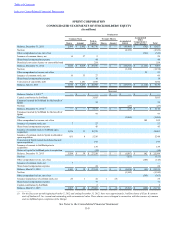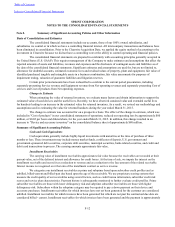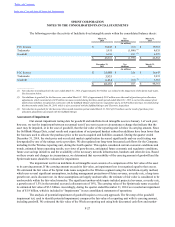Sprint - Nextel 2014 Annual Report Download - page 102
Download and view the complete annual report
Please find page 102 of the 2014 Sprint - Nextel annual report below. You can navigate through the pages in the report by either clicking on the pages listed below, or by using the keyword search tool below to find specific information within the annual report.
Table of Contents
Index to Consolidated Financial Statements
SPRINT CORPORATION
NOTES TO THE CONSOLIDATED FINANCIAL STATEMENTS
F-19
the cumulative effect. The Company is currently evaluating the guidance, including which transition approach will be applied
and the estimated impact it will have on our consolidated financial statements.
In June 2014, the FASB issued authoritative guidance regarding Compensation - Stock Compensation, which
provides guidance on how to treat performance targets that can be achieved after the requisite service period. The updated
guidance requires that a performance target that affects vesting and could be achieved after the requisite service period be
treated as a performance condition and accounted for under current guidance as opposed to a nonvesting condition that would
impact the grant-date fair value of the award. The guidance is effective for annual periods and interim periods within those
annual periods beginning after December 15, 2015 with early adoption permitted. Entities may apply the amendments either
(i) prospectively to all awards granted or modified after the effective date; or (ii) retrospectively to all awards with
performance targets that are outstanding as of the beginning of the earliest annual period presented in the financial statements
and to all new or modified awards thereafter with the cumulative effect as an adjustment to the opening retained earnings
balance as of the beginning of the earliest annual period presented. The Company does not expect the adoption of this
guidance to have a material effect on our consolidated financial statements.
In August 2014, the FASB issued authoritative guidance regarding Disclosure of Uncertainties about an Entity’s
Ability to Continue as a Going Concern, which requires management to assess an entity’s ability to continue as a going
concern and to provide related footnote disclosures in certain circumstances. The updated guidance requires management to
perform interim and annual assessments on whether there are conditions or events, considered in the aggregate, that raise
substantial doubt about an entity’s ability to continue as a going concern within one year after the date that the financial
statements are issued and to provide related disclosures, if required. The standard will be effective for the Company’s fiscal
year ending March 31, 2017, although early adoption is permitted. The Company does not expect the adoption of this
guidance to have a material effect on our consolidated financial statements.
In January 2015, the FASB issued authoritative guidance on Extraordinary and Unusual Items, eliminating the
concept of extraordinary items. The issuance is part of the FASB’s initiative to reduce complexity in accounting standards.
Under the current guidance, an entity is required to separately classify, present and disclose events and transactions that meet
the criteria for extraordinary classification. Under the new guidance, reporting entities will no longer be required to consider
whether an underlying event or transaction is extraordinary, however, presentation and disclosure guidance for items that are
unusual in nature or occur infrequently was retained and expanded to include items that are both unusual in nature and
infrequently occurring. The amendments are effective for the Company’s fiscal year beginning April 1, 2016, although early
adoption is permitted if applied from the beginning of a fiscal year. The Company does not expect the adoption of this
guidance to have a material effect on our consolidated financial statements.
In February 2015, the FASB issued authoritative guidance regarding Consolidation, which provides guidance to
management when evaluating whether they should consolidate certain legal entities. The updated guidance modifies
evaluation criteria of limited partnerships and similar legal entities, eliminates the presumption that a general partner should
consolidate a limited partnership, and affects the consolidation analysis of reporting entities that are involved with variable
interest entities, particularly those that have fee arrangements and related party relationships. All legal entities will be subject
to reevaluation under the revised consolidation model. The standard will be effective for the Company’s annual reporting
period beginning April 1, 2016, including interim periods within that reporting period, although early adoption is permitted.
The Company is currently evaluating the newly issued guidance and assessing the impact it will have on our consolidated
financial statements.
In April 2015, the FASB issued authoritative guidance regarding Interest - Imputation of Interest, which requires
that debt issuance costs related to a recognized debt liability be presented in the balance sheet as a direct deduction from the
carrying amount of that debt liability, consistent with debt discounts. The guidance is effective for fiscal years and interim
reporting periods within those years beginning after December 31, 2015, with early adoption permitted. The standard will be
effective for the Company’s fiscal year beginning April 1, 2016. The Company does not expect the adoption of this guidance
to have a material effect on our consolidated financial statements.
























